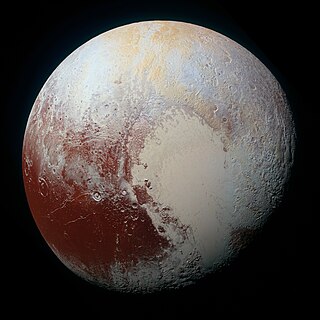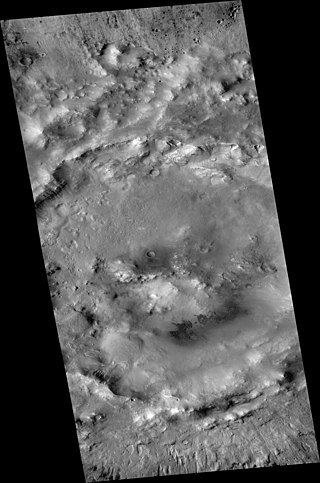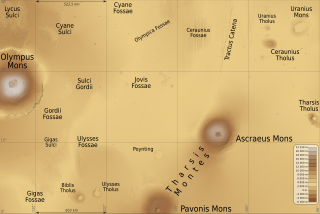Related Research Articles

Planetary nomenclature, like terrestrial nomenclature, is a system of uniquely identifying features on the surface of a planet or natural satellite so that the features can be easily located, described, and discussed. Since the invention of the telescope, astronomers have given names to the surface features they have discerned, especially on the Moon and Mars. To found an authority on planetary nomenclature, the International Astronomical Union (IAU) was organized in 1919 to designate and standardize names for features on Solar System bodies.

Davies is a crater on Mars located at 46°N 0°E on the fringe of Acidalia Planitia near Arabia Terra. It is approximately 48 km in diameter. The crater's name was formally approved by the IAU in 2006.

In planetary nomenclature, a tholus is a small domical mountain or hill. The word is from the Greek θόλος, tholos, which means a circular building with a conical or vaulted roof. The Romans transliterated the word into the Latin tholus, which means cupola or dome. In 1973, the International Astronomical Union (IAU) adopted tholus as one of a number of official descriptor terms for topographic features on Mars and other planets and satellites. One justification for using neutral Latin or Greek descriptors was that it allowed features to be named and described before their geology or geomorphology could be determined. For example, many tholi appear to be volcanic in origin, but the term does not imply a specific geologic origin. Currently, the IAU recognizes 56 descriptor terms. Tholi are present on Venus, Mars, asteroid 4 Vesta, dwarf planet Ceres, and on Jupiter's moon Io.

Suisei Planitia is a large area of smooth plains on Mercury, approximately 570 km wide. Ghost craters are unusual forms that occur in the Suisei Planitia. They are buried and rounded in profile, with only their rim crests rising above the surrounding smooth plains. It has been suggested that material forming Suisei Planitia is ejecta from the impact that formed Caloris Planitia. The name for this Planitia was approved in 1976 by the IAU.

Acidalia Colles is a group of hills in the Mare Acidalium quadrangle of Mars, located at 50.9° north latitude and 23.1° west longitude. It is about 360 km long and was named after a classical albedo feature name. The term "Colles" is used for small hills or knobs. Gullies have been observed on Acidalia Colles.

Ausonia Mensa is a mensa in the Hellas quadrangle of Mars, located at 30.3° S and 262.3° W. It is 103 km (64 mi) across and was named after an albedo feature name. The term "mensa" is used for a flat-topped prominence with cliff-like edges. Ausonia Mensa has many small channels. Some features look like alluvial fans. These channels add to the mass of evidence that water once flowed on Mars. Images of curved channels have been seen in images from Mars spacecraft dating back to the early 1970s with the Mariner 9 orbiter.
Santa Maria is an impact crater on Mars, located at 2.172°S, 5.445°W within the Meridiani Planum extraterrestrial plain, lying situated within the Margaritifer Sinus quadrangle (MC-19) region.

Hesperia Planum is a broad lava plain in the southern highlands of the planet Mars. The plain is notable for its moderate number of impact craters and abundant wrinkle ridges. It is also the location of the ancient volcano Tyrrhena Mons. The Hesperian time period on Mars is named after Hesperia Planum.

Mons is a mountain on a celestial body. The term is used in planetary nomenclature: it is a part of the international names of such features. It is capitalized and usually stands after the proper given name, but stands before it in the case of lunar mountains.

Collis is a small hill or knob on a celestial body. The term is used in planetary nomenclature: it is a part of international proper names of such features. Like other generic terms, it is capitalized and stands after the proper name. As of 2015, only groups of the hills have names, and the term is used only in plural.

PateraPAT-ər-ə is an irregular crater, or a complex crater with scalloped edges on a celestial body. Paterae can have any origin, although the majority of them were created by volcanism. The term comes from Latin, where it refers to a shallow bowl used in antique cultures.
References
- ↑ Bridges, John (July 1, 2015). "Clay-Rich Terrain in Oxia Planum: A Proposed ExoMars Landing Site". Arizona University . Retrieved October 21, 2015.
This article was based on the USGS's Gazetteer of Planetary Nomenclature.
- "Nomenclature Search Results. Mars. Planitia, planitiae". Gazetteer of Planetary Nomenclature. International Astronomical Union (IAU) Working Group for Planetary System Nomenclature (WGPSN). Archived from the original on 2015-04-02. Retrieved 2014-06-16. — current list of planitiae on Mars
- "Nomenclature Search Results. Mars. Planum, plana". Gazetteer of Planetary Nomenclature. International Astronomical Union (IAU) Working Group for Planetary System Nomenclature (WGPSN). Archived from the original on 2015-02-27. Retrieved 2014-06-16. — current list of plana on Mars